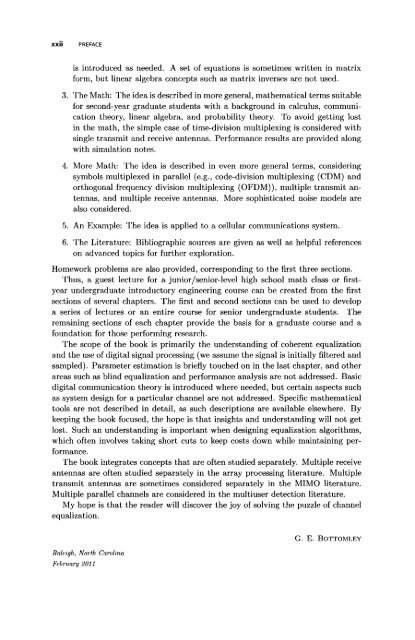mohatta2015.pdf
signal processing from power amplifier operation control point of view
signal processing from power amplifier operation control point of view
You also want an ePaper? Increase the reach of your titles
YUMPU automatically turns print PDFs into web optimized ePapers that Google loves.
XXÜ<br />
PREFACE<br />
is introduced as needed. A set of equations is sometimes written in matrix<br />
form, but linear algebra concepts such as matrix inverses are not used.<br />
3. The Math: The idea is described in more general, mathematical terms suitable<br />
for second-year graduate students with a background in calculus, communication<br />
theory, linear algebra, and probability theory. To avoid getting lost<br />
in the math, the simple case of time-division multiplexing is considered with<br />
single transmit and receive antennas. Performance results are provided along<br />
with simulation notes.<br />
4. More Math: The idea is described in even more general terms, considering<br />
symbols multiplexed in parallel (e.g., code-division multiplexing (CDM) and<br />
orthogonal frequency division multiplexing (OFDM)), multiple transmit antennas,<br />
and multiple receive antennas. More sophisticated noise models are<br />
also considered.<br />
5. An Example: The idea is applied to a cellular communications system.<br />
6. The Literature: Bibliographic sources are given as well as helpful references<br />
on advanced topics for further exploration.<br />
Homework problems are also provided, corresponding to the first three sections.<br />
Thus, a guest lecture for a junior/senior-level high school math class or firstyear<br />
undergraduate introductory engineering course can be created from the first<br />
sections of several chapters. The first and second sections can be used to develop<br />
a series of lectures or an entire course for senior undergraduate students. The<br />
remaining sections of each chapter provide the basis for a graduate course and a<br />
foundation for those performing research.<br />
The scope of the book is primarily the understanding of coherent equalization<br />
and the use of digital signal processing (we assume the signal is initially filtered and<br />
sampled). Parameter estimation is briefly touched on in the last chapter, and other<br />
areas such as blind equalization and performance analysis are not addressed. Basic<br />
digital communication theory is introduced where needed, but certain aspects such<br />
as system design for a particular channel are not addressed. Specific mathematical<br />
tools are not described in detail, as such descriptions are available elsewhere. By<br />
keeping the book focused, the hope is that insights and understanding will not get<br />
lost. Such an understanding is important when designing equalization algorithms,<br />
which often involves taking short cuts to keep costs down while maintaining performance.<br />
The book integrates concepts that are often studied separately. Multiple receive<br />
antennas are often studied separately in the array processing literature. Multiple<br />
transmit antennas are sometimes considered separately in the MIMO literature.<br />
Multiple parallel channels are considered in the multiuser detection literature.<br />
My hope is that the reader will discover the joy of solving the puzzle of channel<br />
equalization.<br />
Raleigh, North Carolina<br />
FeJmtary 2011<br />
G. E. BOTTOMLEY



